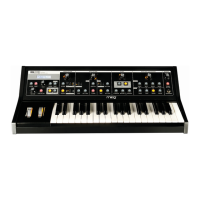Page 44
LP User’s Manual - Appendices
Page 45
LP User’s Manual - Glossary
Glossary
Here are a few key terms that cover the basics of sound generation as used in the Little Phatty synthesizer.
Amplitude – The strength of a sound’s vibration measured in Decibels (dB). Amplitude corresponds to the
musical term Loudness.
Control Voltage – Control voltages (also called CVs) are used in analog synthesizers to affect changes in the
sound. In the case of pitch, pressing a key on the keyboard sends a control voltage that determines the
pitch of the oscillators. The keyboard CV is set to produce an equal tempered scale. As you play up the
keyboard, the CV is raised and the pitch increases. The pitch can also be affected by other CV sources,
like an LFO, often used to produce vibrato. Other major synthesizer components that respond to CV’s
include the lter (the higher the CV, the higher the lter cutoff frequency) and the amplier (the higher
the CV, the higher the gain, or volume).
Envelope – An envelope describes the contours that affect the characteristics of a sound (pitch, tone and
volume) over time. For example, when a string is plucked, its amplitude is suddenly very loud, but then
dies out gradually. This describes the Volume envelope of the sound. We observe that the initial part of
the plucked sound is very bright, but then the brightness fades away. This describes the Tonal envelope
contour. We also hear the frequency of the sound go slightly higher when the string is plucked, and then
drop slightly as the note fades. This is the pitch envelope contour. A synthesizer can create these kinds of
changes by applying electrically generated envelopes to oscillators (affecting pitch), lters (affecting tone)
and ampliers (affecting volume).
Envelope Generator – A circuit that generates an envelope signal. The envelope generator creates a time-
varying signal that can be applied to any voltage-controlled circuit. The Envelope Generators in the Little
Phatty have four adjustable segments: Attack, Decay, Sustain and Release, also sometimes referred to as
ADSR. The Attack, Decay and Release segments are specied as time parameters, while the Sustain seg-
ment is a simply a level setting. Attack species the onset time of the envelope. For example, the sound
of a plucked string starts suddenly, meaning its volume envelope has a fast attack time. Decay species
how quickly the onset of the envelope fades into the sustained portion. Sustain is the level at which the
envelope sustains after the initial transient (the attack and decay portion). Finally, Release determines
how long the envelope takes to fade away. An Envelope Generator uses a trigger to start and stop the
ADSR envelope. This trigger is called a gate signal, and it’s produced whenever a key is pressed on the
keyboard. The gate signal turns on and stays on as long as a key is held down. When the key is released,
the gate signal turns off. When the gate is on, the Envelope Generator is triggered and the envelope
signal moves through the Attack and Decay segments and settles at the Sustain level as long as the
gate signal is on. When the gate goes off, the release segment of the envelope begins. A new gate signal
retriggers the Envelope Generator.
Filter – A circuit that removes some frequencies and allows other frequencies to pass through the circuit. A
lter has a cutoff frequency that determines the point at which frequencies begin to be removed. A low-
pass lter is one in which frequencies above the cutoff frequency are removed and all frequencies below
the cutoff are passed through. A highpass lter is one in which frequencies below the cutoff frequency
are removed and frequencies above the cutoff are passed through. A bandpass lter has two cutoff
frequencies that dene a frequency band, outside of which the frequencies are removed.

